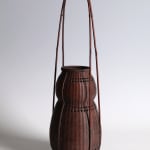Tanabe Chikuunsai II
Gourd-Shaped Flower Basket, ca 1940
Bamboo and rattan
Size 22¼ x 7 x 7 in. (56.5 x 17.5 x 17.5 cm)
T-4989
Further images
-
(View a larger image of thumbnail 1
)

-
(View a larger image of thumbnail 2
)

-
(View a larger image of thumbnail 3
)

-
(View a larger image of thumbnail 4
)

-
(View a larger image of thumbnail 5
)

-
(View a larger image of thumbnail 6
)

-
(View a larger image of thumbnail 7
)

-
(View a larger image of thumbnail 8
)

-
(View a larger image of thumbnail 9
)

Tall bamboo ikebana basket in double-gourd shape, plaited with very narrow strips of split bamboo. The shape is enhanced by superb details throughout the basket using numerous weaving, plaiting and...
Tall bamboo ikebana basket in double-gourd shape, plaited with very narrow strips of split bamboo. The shape is enhanced by superb details throughout the basket using numerous weaving, plaiting and knotting techniques.
The basket is signed on the bottom with an incised signature reading Chikuunsai kore tsukuru (Chikuunsai made this).
It comes with its original faceted and lacquered bamboo otoshi (water container) and with a fitted paulownia-wood storage box.
Born in Sakai City, Osaka, Chikuunsai II studied under his father, Chikuunsai I, from an early age. Using the name Shochikuunsai (“Little Chikuunsai”) from 1925, he first showed his work at the Teiten national fine arts exhibition in 1931. Following the death of Chikuunsai I in 1937, Chikuunsai II succeeded to the family name and began to exhibit frequently both domestically and internationally. He was the leading exponent of bamboo in the Kansai region during his lifetime and played an important part in shepherding the art form through wartime disruption and into the post-war world of department-store exhibitions and international exposure. Chikuunsai II worked in many styles and techniques.
The basket is signed on the bottom with an incised signature reading Chikuunsai kore tsukuru (Chikuunsai made this).
It comes with its original faceted and lacquered bamboo otoshi (water container) and with a fitted paulownia-wood storage box.
Born in Sakai City, Osaka, Chikuunsai II studied under his father, Chikuunsai I, from an early age. Using the name Shochikuunsai (“Little Chikuunsai”) from 1925, he first showed his work at the Teiten national fine arts exhibition in 1931. Following the death of Chikuunsai I in 1937, Chikuunsai II succeeded to the family name and began to exhibit frequently both domestically and internationally. He was the leading exponent of bamboo in the Kansai region during his lifetime and played an important part in shepherding the art form through wartime disruption and into the post-war world of department-store exhibitions and international exposure. Chikuunsai II worked in many styles and techniques.








